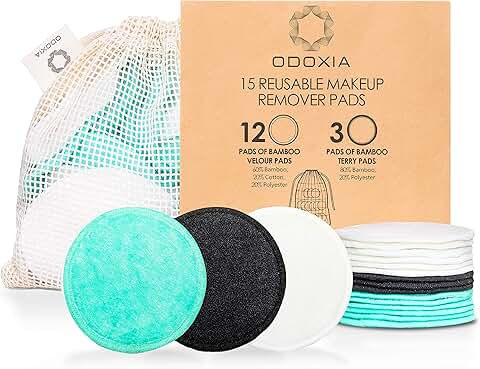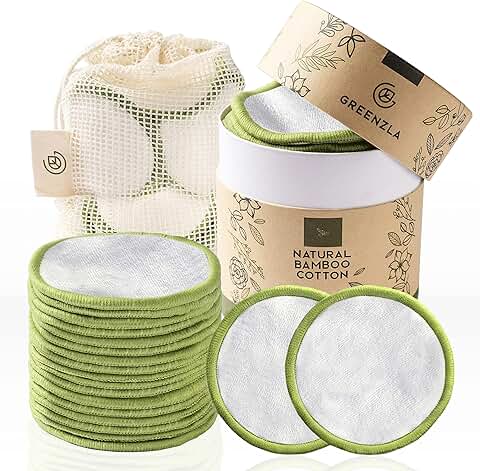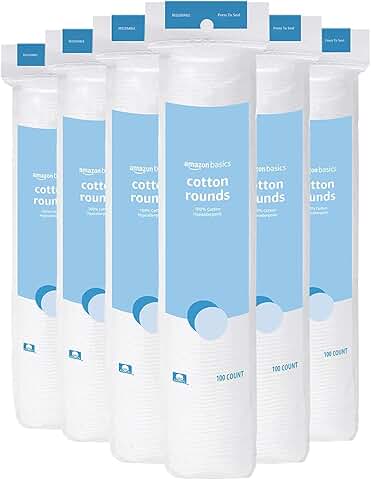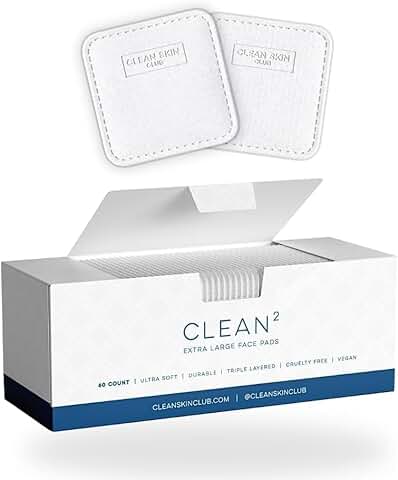Introduction
I’ve been there – staring at a pile of used cotton rounds and feeling guilty about the waste. It’s what led me down the rabbit hole of exploring choices to traditional disposable makeup remover pads.
The beauty industry is evolving, offering more sustainable options for makeup removal.
But there’s a lot more to consider than just eco-friendliness.
Finding the right makeup remover solution involves balancing effectiveness for our skin, practicality for our lifestyle, and responsibility towards our planet. Each choice we make, even something as seemingly small as how we remove our makeup, has an impact on the world around us.
Of course, we need products that actually work. An eco-friendly option that leaves us with raccoon eyes defeats the purpose.
Let’s explore the pros and cons of both reusable and disposable options to find a solution that’s good for our skin and our conscience.
The Reusable Revolution
Reusable makeup remover pads have gained significant popularity recently. These fabric rounds promise to reduce waste while still effectively removing makeup.
But do they live up to the hype?
Let’s take a closer look.
Materials Matter
Many reusable pads are made from materials like bamboo, organic cotton, or microfiber. Bamboo has become particularly popular in the eco-friendly beauty world.
Odoxia Reusable Makeup Remover Pads is a good eco-friendly choice. Click here to get more information.

Greenzla Reusable Makeup Remover Pads (20 Pack) uses organic cotton and natural bamboo. Click here to get more information.

Amazon Basics Hypoallergenic 100% Cotton Rounds. Click here to get more information.

It grows quickly without pesticides, feels incredibly soft on the skin, and has natural antibacterial properties.
A set of bamboo reusable pads can last for hundreds of uses when properly cared for. This longevity potentially saves you from tossing out over 700 disposable pads annually.
That’s a significant reduction in waste!
The Maintenance Factor
Reusable pads need regular washing, which means having enough on hand to last between laundry days. Some users report that the pads can become less effective over time, especially with heavy makeup use.
There’s also the psychological hurdle of using the same pad on your face repeatedly, which might make some people uncomfortable.
Long-Term Savings
While the upfront cost of a set of reusable pads might seem high, the long-term savings can be substantial. A study I found suggested that switching to reusables could save the average person $50-$100 per year.
Over several years, those savings add up significantly.
The Disposable Dilemma
On the other side of the debate, we have our familiar disposable cotton rounds. They’re convenient, hygienic (in the sense that you use a fresh one each time), and readily available.
However, they come with their own set of challenges.
Environmental Impact
Here’s a sobering fact: disposable cotton pads can take up to 5 years to decompose in landfills. When you multiply that by the number of pads used globally, we’re looking at a significant environmental impact.
A 2019 study published in the Journal of Cleaner Production found that reusable cotton pads have a substantially lower environmental impact compared to disposable options over their lifecycle.
Innovation in Disposables
To their credit, some companies are innovating in the disposable space. For example, the Clean Skin Club Clean² Pads 2.0 boast a unique triple-layer design and improved edges to prevent shedding and tearing.
They’re made from organic cotton and are designed to be more effective and less wasteful than traditional options.
Click here if you want to give Clean Skin Club’s disposable pads a try.
The Hybrid Approach
For those who can’t quite commit to fully reusable or disposable options, there’s a middle ground. Some companies offer biodegradable disposable pads, while others have created semi-reusable options that can be used a few times before being discarded.
Making the Switch: A Step-by-Step Guide
If you’re considering making the switch to reusable pads, here’s a comprehensive guide to help you transition smoothly:
1. Start Small
Begin with a set of 7-10 reusable pads to see how you like them. This allows you to test the waters without committing to a complete overhaul of your routine.
You can always expand your collection later if you find them effective.
2. Choose Your Material
Consider your skin type when selecting between bamboo, cotton, or microfiber options. Bamboo is naturally antibacterial and soft, making it suitable for sensitive skin. Cotton is absorbent and gentle, while microfiber is excellent for removing stubborn makeup but may be too harsh for some skin types.
3. Invest in a Laundry Bag
A mesh laundry bag will keep your pads together in the wash and prevent them from getting lost or tangled with other items. This small investment makes the cleaning process much more manageable.
4. Establish a Routine
Decide how often you’ll wash your pads and stick to it. Some people prefer to wash them after each use, while others collect them for a weekly wash.
Find a schedule that works for you and your lifestyle.
5. Proper Care
Follow the care instructions carefully to extend the life of your pads. Most can be machine washed in warm water and air-dried. Avoid using fabric softeners, as they can leave a residue that reduces the pad’s effectiveness.
6. Be Patient
It might take a few uses to get used to the texture and effectiveness of reusable pads. Give yourself time to adjust and experiment with different cleansing products to find the perfect combination for your skin.
Common Pitfalls and How to Avoid Them
Inadequate Cleaning
Ensure you’re washing your reusable pads thoroughly to prevent bacterial growth. Use a gentle, unscented detergent and consider adding a few drops of tea tree oil for it’s antibacterial properties.
Overuse
Even reusable pads have a lifespan. Replace them when they start to show signs of wear and tear, such as fraying edges or a change in texture.
Most high-quality pads should last several months to a year with proper care.
Incompatibility with Products
Some reusable pads may not work well with oil-based makeup removers. Experiment to find the right combination of pad material and cleansing product for your skin and makeup type.
Storage Issues
Keep your clean pads in a dry, clean place to prevent mold growth. A small, breathable container or drawer organizer works well for this purpose.
Adapting to Different Scenarios
Traveling with Reusable Pads
Traveling with reusable pads can be tricky, but it’s not impossible. For shorter trips, bring enough pads to last the duration of your progress and store used ones in a waterproof bag until you can wash them.
For longer trips, consider bringing a mix of reusable and biodegradable disposable options.
Everyday Use
For everyday use, having multiple sets of reusable pads can help confirm you always have clean ones on hand. Consider keeping a set at home and another at work or in your gym bag for convenience.
The Environmental Impact: A Closer Look
The environmental benefits of switching to reusable pads extend beyond just reducing waste in landfills. Let’s examine the broader ecological implications:
Water Usage
While reusable pads need washing, which uses water, the overall water footprint is still lower than that of disposable pads. The production of disposable cotton pads involves significant water usage in cotton farming and processing.
Carbon Footprint
The production and transportation of disposable pads contribute to a higher carbon footprint compared to reusable options. A single set of reusable pads can replace hundreds of disposable ones, significantly reducing the energy and resources needed for manufacturing and distribution.
Plastic Reduction
Many disposable pads come packaged in plastic, contributing to the global plastic waste problem. Reusable pads often come in minimal, eco-friendly packaging, further reducing plastic consumption.
Biodiversity Impact
Cotton farming for disposable pads can have negative impacts on local ecosystems because of pesticide use and water diversion. Sustainable materials used in reusable pads, like organic cotton or bamboo, have a lower impact on biodiversity.
The Skincare Perspective
While environmental concerns are crucial, it’s equally important to consider how different pad options affect our skin health:
Sensitivity and Irritation
Some people find that reusable pads, especially those made from natural fibers like bamboo or organic cotton, are gentler on their skin. This can be particularly useful for people who have sensitive skin or conditions like eczema or rosacea.
Makeup Removal Efficiency
The texture of reusable pads can vary, affecting their ability to remove makeup effectively. Microfiber pads are often praised for their ability to remove even stubborn waterproof makeup, while cotton or bamboo pads may need a bit more product or effort.
Exfoliation
Some reusable pads offer a mild exfoliating effect, which can be useful for skin cell turnover. However, this may not be suitable for daily use on sensitive skin types.
Product Absorption
Reusable pads may absorb less product compared to disposable cotton rounds, potentially leading to less waste of expensive skincare products.
Economic Considerations
The financial aspect of choosing between reusable and disposable pads is worth exploring in more depth:
Initial Investment vs. Long-Term Savings
Reusable pads need a higher upfront cost, but they offer significant savings over time. Let’s break down the numbers:
- A set of 20 high-quality reusable pads might cost around $20-$30.
- A pack of 100 disposable cotton rounds typically costs $5-$10.
Assuming you use two pads per day:
- With disposables, you’d go through about 730 pads per year, costing $36-$73 annually.
- Reusable pads, even if replaced annually, would cost $20-$30 per year.
Over five years, the savings could range from $80 to over $200, depending on the quality and price of the products you choose.
Hidden Costs
Consider extra factors like:
- Laundry costs for reusable pads (minimal if washed with regular loads)
- Potential savings on makeup remover product (some users report needing less product with reusable pads)
- Time spent on maintenance (washing and drying reusable pads)
The Psychology of Change
Switching from disposable to reusable pads involves more than just a practical change – it’s a shift in mindset:
Overcoming Habits
We’re creatures of habit, and changing a daily routine can be challenging. It takes time to adjust to new textures, washing routines, and the idea of reusing something on our face.
Eco-Anxiety and Action
For many, making the switch to reusable pads is driven by eco-anxiety – the fear or worry about environmental issues. Taking concrete actions, like adopting reusable beauty products, can help reduce this anxiety by giving us a sense of control and positive impact.
The Ripple Effect
Often, making one eco-friendly change can inspire further sustainable choices in other areas of life. Starting with makeup remover pads might lead to exploring other reusable beauty products or sustainable lifestyle changes.
Innovation in the Beauty Industry
The debate between reusable and disposable pads has spurred innovation in the beauty industry:
Biodegradable Disposables
Some companies are developing truly biodegradable disposable pads made from materials like bamboo or cotton that break down much faster than traditional options.
High-Tech Reusables
Advances in fabric technology have led to reusable pads with enhanced properties, such as antimicrobial fibers or specially designed textures for better makeup removal.
Cleansing Devices
The popularity of reusable options has also boosted interest in electronic cleansing devices that use reusable pads or brushes, offering an choice to traditional makeup removal methods.
Cultural Perspectives
The adoption of reusable beauty products varies across cultures:
Zero Waste Movement
In countries where the zero waste movement is strong, like parts of Europe and North America, reusable pads have gained significant traction.
Traditional Practices
Some cultures have long-standing traditions of using reusable cloths for skincare, making the transition to modern reusable pads more natural.
Hygiene Perceptions
In some regions, there may be stronger cultural emphasis on single-use products for perceived hygiene reasons, presenting a challenge for reusable options.
The Role of Influencers and Social Media
Social media has played a significant role in the rise of reusable beauty products:
Eco-Influencers
Many social media influencers have championed reusable pads, showcasing their use and benefits to large audiences.
DIY Tutorials
Platforms like YouTube and Instagram are filled with tutorials on making your own reusable pads, further popularizing the concept.
Brand Collaborations
Influencer partnerships with eco-friendly beauty brands have helped bring reusable options to mainstream attention.
The Future of Makeup Removal
As we look ahead, several trends are shaping the future of makeup removal:
Technological Advancements
We’re likely to see continued innovation in materials and designs for both reusable and disposable options, potentially blurring the lines between the two categories.
Personalization
The beauty industry is moving towards more personalized solutions. We might see makeup remover pads tailored to specific skin types or concerns.
Sustainability Integration
As sustainability becomes more integral to beauty routines, we can expect to see more brands offering reusable options or improving the eco-credentials of their disposable products.
Multifunctional Products
Future makeup remover pads might incorporate skincare benefits, such as built-in serums or treatments, offering a more comprehensive skincare step.
Making an Informed Choice
Ultimately, the decision between reusable and disposable makeup remover pads is personal. Consider these factors when making your choice:
- Skin type and sensitivity
- Makeup habits (frequency and type of makeup worn)
- Environmental concerns
- Budget
- Lifestyle and time for maintenance
- Travel frequency
Remember, it doesn’t have to be an all-or-nothing decision. Many people find a balance by using a combination of reusable and disposable options depending on the situation.
Frequently Asked Questions
Are reusable makeup remover pads hygienic?
Reusable makeup remover pads can be hygienic when properly cleaned and maintained. Regular washing with hot water and gentle detergent, followed by thorough drying, helps prevent bacterial growth. Some users also sanitize their pads by boiling them periodically.
How often should I wash my reusable makeup remover pads?
It’s best to wash reusable makeup remover pads after each use. However, if this isn’t practical, aim to wash them at least once a week.
Store used pads in a dry, well-ventilated container until wash day to prevent mold growth.
Can I use oil-based makeup removers with reusable pads?
While you can use oil-based makeup removers with reusable pads, some materials may not work as effectively. Microfiber pads tend to work well with oil-based products, while cotton or bamboo pads might need more product or effort.
Always check the manufacturer’s recommendations.
How long do reusable makeup remover pads last?
With proper care, high-quality reusable makeup remover pads can last anywhere from 6 months to over a year. The lifespan depends on factors like frequency of use, washing methods, and the quality of the pads.
Are bamboo makeup remover pads better than cotton ones?
Bamboo makeup remover pads offer several advantages over cotton. They’re naturally antibacterial, more sustainable (bamboo grows faster than cotton), and often softer on the skin. However, cotton pads can be equally effective and may be more readily available or affordable.
Do reusable makeup remover pads work on waterproof makeup?
Many reusable makeup remover pads, especially those made from microfiber, are effective at removing waterproof makeup. However, you may need to use a specialized makeup remover product in conjunction with the pad for stubborn waterproof formulas.
Can reusable makeup remover pads cause breakouts?
When properly cleaned and maintained, reusable makeup remover pads shouldn’t cause breakouts. In fact, some users report fewer skin issues after switching to reusable pads.
If you experience breakouts, confirm you’re washing the pads thoroughly and consider trying a different material or cleaning method.
Are there any eco-friendly disposable makeup remover pad options?
Yes, some brands offer eco-friendly disposable makeup remover pads made from biodegradable materials like bamboo or organic cotton. These options break down more quickly in landfills compared to traditional disposable pads.
How do I clean stubborn makeup stains from reusable pads?
For stubborn makeup stains on reusable pads, try pre-treating them with a gentle stain remover or a mixture of baking soda and water before washing. Avoid using harsh chemicals that might irritate your skin when you use the pad next.
Can I use reusable makeup remover pads for other skincare steps?
Many people use reusable makeup remover pads for other skincare steps like applying toner or essence. Just be sure to use separate pads for different products to avoid mixing ingredients unintentionally.
Key Takeaways
- Reusable makeup remover pads offer significant environmental benefits and potential cost savings over time.
- Proper care and maintenance are crucial for the effectiveness and longevity of reusable pads.
- Disposable options provide convenience but come with environmental concerns.
- The choice between reusable and disposable depends on personal preferences, skin type, and lifestyle.
- Many people find success with a hybrid approach, using both reusable and disposable options as needed.
- Innovation in the beauty industry continues to improve both reusable and disposable options.
- Making the switch to reusable pads can be part of a larger shift towards more sustainable beauty practices.
